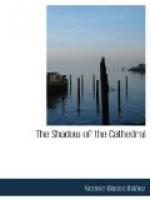Gabriel nodded his head assenting to the words of the Chapel-master.
“This was the first Christian music,” continued Don Luis. “Confided to tradition and transmitted orally, the religious songs soon became disfigured and corrupt. In every church they sang in a different way, and religious music became a hotch-potch. The mystics leaned to rigid unity, and in the sixth century Saint Gregory published his ‘Antifonario,’ a collection of all liturgic melodies, purifying them according to his ideas. They were a mixture of two elements: the Greek, rather oriental and florid, very much like the present debased style; and the grave and rough Roman. The notes were expressed by letters, the Phrygian and Lydian styles followed, and so the intricacies of Greek music continued though much altered, with fioriture, rests, and breathing pauses. The collection became lost, and many who think a return to the old style would be best, much regret it. To judge by the fragments that remain, if such music was now executed it would have very little that was religious about it, as we understand religion in art to-day; it would more resemble the songs of the Moors, or the Chinese, or those of some schismatic Greeks who still use the ancient liturgies. The harp was the principal instrument in the churches till the organ appeared in the tenth century, a rough and barbarous instrument that had to be played with blows, and was supplied with wind from inflated skins. Guido di Arezzo made a musical rule on the basis of Gregory’s collection, and this was sufficient for the invention of the pentagramma[1] to be assigned to the Benedictine. They continued to use the letters of Boccio and Saint Gregory as notes, but they placed them on lines of three different colours. The imbroglio continued; to learn music badly took twelve years, and then they could not manage that singers from different towns could read from the same score. Saint Bernard, dry and austere as his times, ridiculed this music as not being solemn enough; he was a man antagonistic to all art; he would have liked to see the churches dismantled and without any architectural adornments; and the slower the music was, the better it seemed to him. He was the father of plain song, and he maintained that the more drawn out the music was, the more religious it became. But in the thirteenth century Christians found this chant most wearisome. The cathedrals in those days were the point of attraction: the theatre, the centre of all life. People went to the church to pray to God and to amuse themselves, forgetting for the moment all the wars and the violence and confusion outside. Once again popular music came into the churches, and you could hear intoned in the cathedrals all the songs most in vogue, and which were often obscene. The people took part in the religious music, singing in different tones, each one as seemed best to him, and these were the first beginnings of concerted singing. In those days religion was




